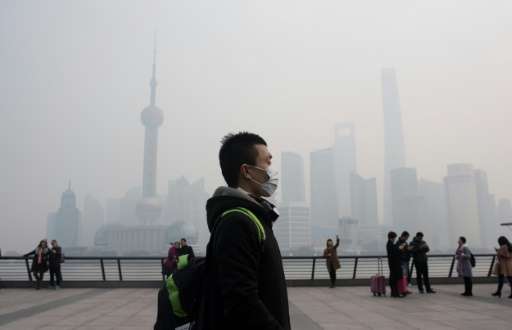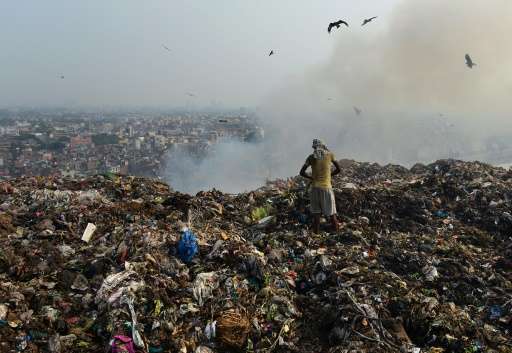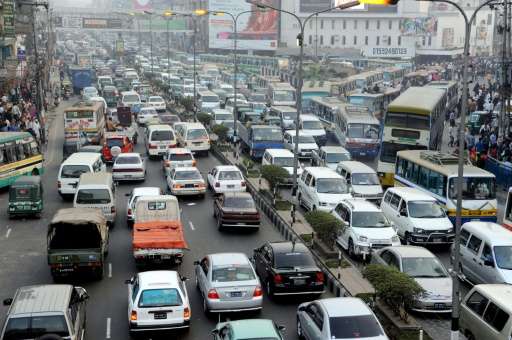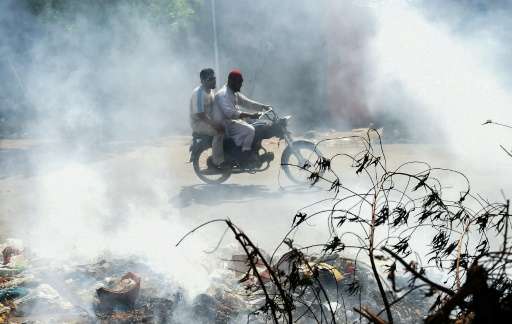Asia's poor choking on filthy air

Polluted air is a "public health emergency", the World Health Organization said Tuesday, adding nine out of 10 people globally breathe bad air that is blamed for more than six million deaths a year.
And the WHO warned that nearly 90-percent of air pollution-related deaths occur in low and middle-income countries.
Southeast Asia and the Western Pacific region—including China—are the hardest hit, the data showed.
South Asia is also badly affected, with the WHO saying poor air quality is responsible for the deaths of more than 600,000 people in India and 37,000 people in Bangladesh every year.
Pakistan too is suffering, with experts blaming unplanned and unsustainable development and warning that proposals for more coal-fired power stations will further worsenair quality.
Smog is a perennial problem across China, where pollution from heavy industry and a rapidly growing fleet of cars brews a toxic haze that, in the winter, can wreathe whole regions in a choking miasma.
Even Shanghai, reputed to have some of China's cleanest air, struggles with constant haze: in 2015 readings of dangerous fine-particulate matter known as PM 2.5 averaged twice the WHO's daily recommended maximum exposure of 25, according to government data.
Here are snapshots from four Asian cities:

NEW DELHI
In the shadow of a massive smouldering rubbish dump outside India's sprawling capital, Ritu Devi fears for her children whom she says constantly fall sick from dirty air.
"Everything hurts. My eyes burn, my head hurts and I feel very dizzy at times," said Devi, who guesses her age at 22 or 23.
"My children keep coughing and falling sick. My eyes burn and they start to water. These things keep happening to us," she said, as her two-year-old daughter sat on her lap and tugged on her sari.
"We suffer because of all this smoke and pollution," said Devi, whose husband works at a nearby market.
Locals living near the huge Ghazipur landfill site complain of chronic headaches, wheezing and recurring bouts of fevers and colds as methane from decomposing waste escapes the landfill and fills their homes. The methane, which traps heat, also sparks fires and smoke regularly billows from the site.
DHAKA
On a road choked with traffic in the Bangladeshi capital, 22-year-old rickshaw puller Nur Alam stops for a break.

Alam started riding a bicycle taxi five years ago, competing with motorbikes and cars for space on Dhaka's streets, after he arrived from his village in the south in the hope of making some money.
"I often feel suffocated while I work, especially, when I'm stuck in traffic jams," Alam said. "The strong smell of black smoke and the open garbage dumps sometimes weaken me," the father-of-one said.
"Sometimes I see white rashes on my skin. I have never visited a doctor to check it, but I think it's because of the pollution I have to face everyday," he added.
Like thousands of other rickshaw pullers, Alam works about 12 hours a day, seven days a week, rarely taking a day off in one of the world's most populated and congested cities.
"I have no other means of income but pulling rickshaws to feed my family. I really have little choice," Alam said.
KARACHI
In Pakistan's largest city and commercial hub, Abdul Aziz, a 65-year-old rickshaw driver, said the pollution was suffocating.
"In traffic jams, the smoke emitting from bus and other vehicles is badly suffocating—it makes me feel very ill," he said.

"I am a diabetic and the pollution further aggravates my illness. The environmental pollution is impacting my health and it becomes extremely difficult for me to drive the rickshaw in the suffocating traffic jams.
"So I have to park the vehicle on the side of the road till I catch my breath back."
Mohammad Rameez, a 25-year-old office worker, called for the most polluting vehicles to be banned.
"As you can see, traffic is immense in the city of Karachi. There is no implementation of a law for those polluting vehicles which are emitting smoke," he said.
"They should be guided, banned or stopped plying on the roads. Most of the vehicles being used are as old as the 1990s, so they all are contributing to pollution dangerously and affecting human health very badly."
SHANGHAI
Dong Weiwei, a courier in his late 20s originally from Henan province, works outdoor riding his scooter delivering packages in Shanghai.
He said air pollution affects him, but his company does not supply masks or other protective equipment.
"Sometimes I feel I have difficulties breathing when the air is bad, but I rarely take any precautions about this. I have neither the time nor the money to do that."
© 2016 AFP





















